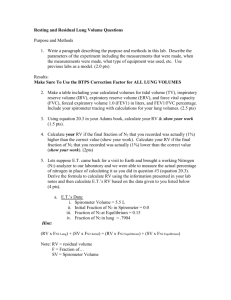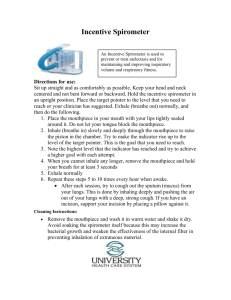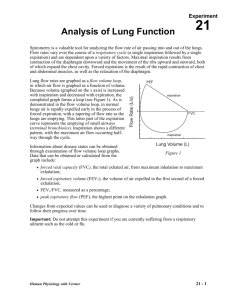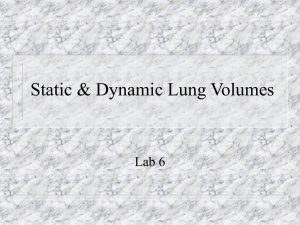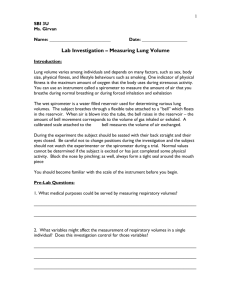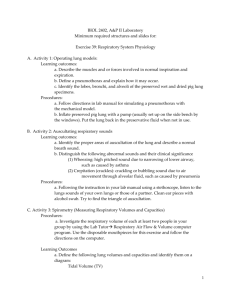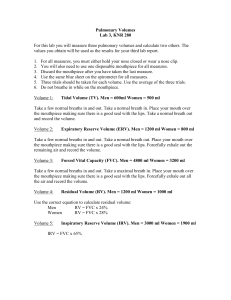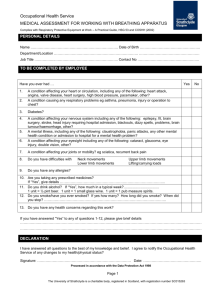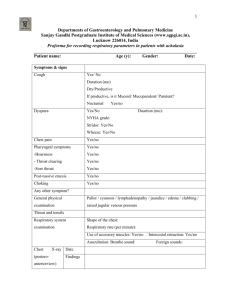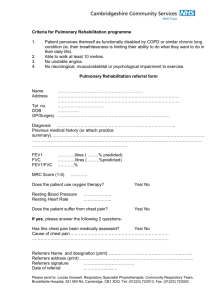Respiratory function tables
advertisement
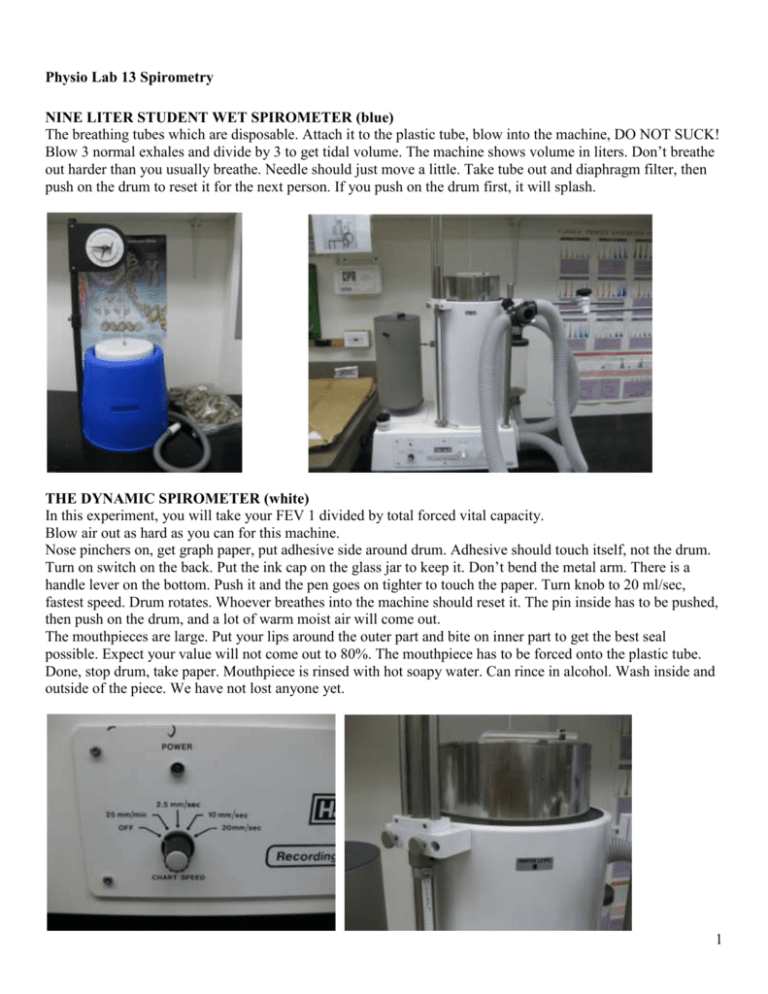
Physio Lab 13 Spirometry NINE LITER STUDENT WET SPIROMETER (blue) The breathing tubes which are disposable. Attach it to the plastic tube, blow into the machine, DO NOT SUCK! Blow 3 normal exhales and divide by 3 to get tidal volume. The machine shows volume in liters. Don’t breathe out harder than you usually breathe. Needle should just move a little. Take tube out and diaphragm filter, then push on the drum to reset it for the next person. If you push on the drum first, it will splash. THE DYNAMIC SPIROMETER (white) In this experiment, you will take your FEV 1 divided by total forced vital capacity. Blow air out as hard as you can for this machine. Nose pinchers on, get graph paper, put adhesive side around drum. Adhesive should touch itself, not the drum. Turn on switch on the back. Put the ink cap on the glass jar to keep it. Don’t bend the metal arm. There is a handle lever on the bottom. Push it and the pen goes on tighter to touch the paper. Turn knob to 20 ml/sec, fastest speed. Drum rotates. Whoever breathes into the machine should reset it. The pin inside has to be pushed, then push on the drum, and a lot of warm moist air will come out. The mouthpieces are large. Put your lips around the outer part and bite on inner part to get the best seal possible. Expect your value will not come out to 80%. The mouthpiece has to be forced onto the plastic tube. Done, stop drum, take paper. Mouthpiece is rinsed with hot soapy water. Can rince in alcohol. Wash inside and outside of the piece. We have not lost anyone yet. 1 Calculate the data. At the time you start breathing, the pen starts at top left and moves inferiorly. Measure 20 ml, in one second is 4 mm. From start of exhale to one second, for every mm = 30 ml of air exhaled. Can measure how much total air you blew out (FVE), translate mm = 30 ml. FEV / TFVC = 80% In lab manual, mistakes: p. 40; towards the bottom, it says your subject predictied for FVC. Take that from the chart in the back. What % is this of normal? I am trying to ask this: take your calculated FEV1 and divide by your predicted one in the chart, what you should be. For the next one, %FVC means FEV1/FEV. Your normal % should be 80%. Take your calculated value and divide it by what it should be for your age and height. 2 AN EXERCISE IN THE USE OF THE SPIROMETER-LUNG CAPACITIES & VOLUMES INTRODUCTION The spirometer is an instrument that is normally used to measure the flow of air in and out of the lungs under varying conditions. The wet spirometer is based on the simple mechanical principle that air, exhaled from the lungs, will cause displacement of a closed chamber which is partially submerged in water. Basically, it consists of two vessels: a larger vessel containing water and having a breathing hose attached to it; and a smaller vessel inverted and suspended in the water. A counterweight and indicator are attached to the inverted chamber. Air blown into the inverted chamber will cause it to rise, thus moving an indicator arrow which is calibrated in liters, to give lung volume measurements. In this exercise, you will use the wet spirometer to measure only exhalations. Therefore all of the inhalation data will be calculated using mathematical relationships. Lung Volumes: There are four pulmonary lung volumes that, when added together, equal the maximum volume to which the lungs can be expanded. These are: 1. Tidal Volume (TV) is the volume of air inspired or expired with each normal breath; it amounts to about 500 milliliters in the adult male. 2. Inspiratory Reserve Volume (IRV) is the extra volume of air that can be inspired over and above the normal tidal volume when the person inspires with full force; it is usually equal to about 3100 milliliters. 3. Expiratory Reserve Volume (ERV)is the maximum extra volume of air that can be expired by forceful expiration after the end of a normal tidal expiration; this normally amounts to about 1200 milliliters. 4. Residual Volume (RV) is the volume of air remaining in the lungs after the most forceful expiration; this volume cannot be voluntarily exhaled, so it must be measured by other methods than those available to us; this volume averages about 1200 milliliters Pulmonary Capacities are the sum of two or more of the volumes. Capacities are measured in volume units. There are four, and these are: 1. Inspiratory Capacity (IC) equals the tidal volume plus the inspiratory reserve volume. This is the amount of air (about 3600 milliliters) a person can breathe in, beginning at the normal expiratory level and distending the lungs to the maximum amount. (IC = TV + IRC) 3 2. Functional Residual Capacity (FRC) equals the expiratory reserve volume plus the residual volume. This is the amount of air that remains in the lungs at the end of normal expiration (about 2400 milliliters). (FRC = ERV + RV) 3. Vital Capacity (VC) equals the inspiratory reserve volume plus the tidal volume plus the expiratory reserve volume. This is the maximum amount of air a person can expel from the lungs after first filling the lungs to their maximum extent and then expiring to the maximum extent (about 4800 milliliters). (VC = IRV +TV + ERV) 4. Total Lung Capacity (TLC) is the maximum volume to which the lungs can be expanded with the greatest possible effort (about 6000 milliliters); it is equal to the vital capacity plus the residual volume. (TLC = IRV +TV + ERV +RV) MATERIALS NEEDED A bell (wet) spirometer provided on the countertop. PROCEDURES Work as a small group and collect the data from one subject. Insert a clean disposable mouthpiece into the oneway valve in the hose. Once a student has exhaled into the spirometer, the bell will rise with the air in it. To start with an empty bell, one must gently remove the one-way valve at the end of the hose before the bell will sink and reset to the bottom of the housing. Reattach the one-way valve and mouthpiece after the bell has been released. 1. Measure TIDAL VOLUME (TV) The tidal volume represents the amount of air that is inspired or expired during a normal breathing cycle. To directly measure this volume, start with the dial of the spirometer set to zero. Rotate the outer, larger circular scale dial at the top of the spirometer until the scale is horizontal and the pointer reads at the zero mark. Hold or clip your nose shut while exhaling to prevent any air from leaking through the nostrils. The subject should be standing and facing forward, but not looking at the dial. Relax and breathe normally, inhaling through the nose. When ready, attach to the mouthpiece sealing the lips around it, and exhale THREE normal breaths into the spirometer, inhaling room air through the nose between each exhalation. Do not forcibly exhale. The dial on the spirometer should move slightly with each exhalation. Record the dial reading after the three exhalations. Take the reading and divide this value by three to get the average tidal volume. The unit will be in cubic centimeters (cc) or milliliters (ml.) Why is it good practice to take three breaths and then divide by three to get the average TV? For reference, a normal TV is about 400 to 500cc. Calculate your average TV here: Bell (Wet)-spirometer 4 2. Measure MINUTE RESPIRATORY VOLUME (MRV) The minute respiratory volume (MRV) is the volume of air that passes in or out of the lungs per minute. To calculate this value, count the number of normal breaths the subject takes when breathing normally over one minute and multiply this by the average TV: MRV = Ventilation Rate x TV Calculate your MRV here: 3. Measure EXPIRATORY RESERVE VOLUME (ERV) Measure the amount of air that can be forcibly breathed out after normal expiration (ERV) After taking three normal breaths and exhaling normally into the room after each, on the last breath, attach to the mouthpiece and continue to forcibly exhale as much air as possible. Record the number of cc (or ml). The normal values for males, aged 20-30 years is about 1200 cc and from 30-60 years is about 1000 cc. Females aged from 20-30 years, the normal value is 1000 cc and for females over age 30, the normal ERV is 900 cc. Write your ERV here: 4. Measure VITAL CAPACITY (VC) Measure the maximum amount of air which can be forcibly exhaled immediately following a maximal inhalation (VC) (Max in to Max out.) Set the spirometer dial to "zero". Determine the VC by taking three deep breaths and exhaling completely after each inspiration. On the fourth deepest full breath, exhale all of the air into the spirometer. Do not "puff" hard through the spirometer but instead, use a slow forced exhalation and "give it all you got". For norms, see charts in the back of this exercise, or use the VC formulas below: MALES: VC (in liters) = (0.052 x H) - (0.022 x A) - 3.60 FEMALES: VC (in liters) = (0.041 x H) - (0.018 x A) - 2.69 Where "H" = height in centimeters (2.54 cm = 1inch) "A" = age in years to nearest birthday Example: calculate the VC of a 28 year-old female who is 5'7" (170.18 cm) in height. Answer: 3.786 liters. Calculate your VC using the equation above: What was your VC from the spirometer? What is your VC from the chart at the end of this exercise? 5 Quite often, the VC is expressed as a percentage of the spirometery-obtained VC compared to the calculated VC. Therefore, VC Percentage = VC (in liters) from Spirometer Reading VC (in liters) from formula or chart x 100 Your Vital Capacity Percent should be very close to 100% because this would be the normal percentage for a healthy person or non Chronic Obstructive Pulmonary Disease (COPD) person. Calculate your VC% here: 5. Determine INSPIRATORY CAPACITY (IC) The inspiratory capacity (IC) is the total amount of air one can draw in after a normal exhalation. You will obtain this value indirectly, as we do not wish to inhale air contained in the spirometer. The formula is: IC = VC - ERV Calculate your IC here: 6. Measure INSPIRATORY RESERVE VOLUME (IRV) The inspiratory reserve volume (IRV) is the amount of air that can be inhaled after normal inspiration. You will obtain this value indirectly, as we do not wish to inhale air contained in the spirometer. The formula is: IRV = IC - TV Calculate your IRV here: 7. Determine RESIDUAL VOLUME (RV) The residual volume is the amount of air left in the lungs after the most forceful expiration. This cannot be voluntarily exhaled, but can only be squeezed out of a nonliving lung. It is measured by indirect methods, and has been experimentally determined for normal persons of different age/sex. We can assume you fit the normal. See chart below and highlight your RV range: FOR MEN Age RV 14-19: 830 cc 20-29: 1410 cc 30-39: 1510 cc 40-49: 1690 cc 50-59: 1740 cc FOR WOMEN Age RV 14-19: 820 cc 20-29: 1290 cc 30-39: 1310 cc 40-49: 1390 cc 50-59: 1300 cc 6 60-75: 1760 cc 60-64: 1200 cc 8. Determine FUNCTIONAL RESIDUAL CAPACITY (FRC) The functional residual capacity (FRC) is defined as the amount of air remaining in the lungs after normal expiration. This is a very important volume, as it represents the volume of air in the lung at the equilibrium position in the tug of war between opposing forces of the lung and chest wall. It too, cannot be completely exhaled, as it is made up partly of the residual volume from the previous step. The formula is: FRC = ERV + RV Calculate your FRC here: 9. TOTAL LUNG CAPACITY (TLC) The total lung capacity (TLC) is the total amount of air in the lungs after maximal inspiration. This value may be determined by either formula: TLC = FRC + IC OR TLC = RV + VC. If you calculated correctly in previous steps, you should get the same answer for both methods. The normal TLC for males is about 6000 cc and for females, about 4200 cc. Calculate your TLC here: Study Questions: What is a spirometer? Be sure you know the definitions for ALL volumes and capacities and how to calculate them: Tidal volume, MRV, ERV, Vital capacity, VC percentages, IC, IRV, FRC, RV, and TLC. PRACTICE SPIROMETRY PROBLEMS: 1. Given: VC = 4300 ml IC = 3000 ml TV = 400 ml RR = 16/min Calculate: a) IRV b) ERV c) MRV 2. Given: TV = 400 ml IRV = 2600 ml ERV = 1000 ml RR = 12/min Calculate: a) VC b) IC c) MRV 3. Given: IRV IC RV VC Calculate: = 2800 ml = 3250 ml = 1200 ml = 5375 ml a) TV b) ERV c) TLC 7 MEASUREMENT OF LUNG FUNCTION: FORCED EXPIRATORY VOLUME (FEV1.0) INTRODUCTION This is a rapid but valuable test of lung function. This is a dynamic lung test, one that takes into account how rapidly you can move air out of the lungs across airways. Rate of airflow is volume/ time. You will be using a research grade recording spirometer for this exercise. This consists of a wet spirometer with an attached rotating drum with pen for recording volume changes. Pulmonary function tests are often used in diagnosis of respiratory disease. The particular test you are doing today is a more valuable test in diagnostics than are simple lung volume and capacity measurements (static lung tests) because it examines the rate or speed of exhalation (dynamic testing.) The rate of exhalation is often affected in obstructive lung disease. This test is also known as a "forced vital capacity" or "FVC" because the subject first maximally inhales and then maximally exhales into the spirometer. You are asked to work in pairs or small groups, one of you being the subject and the other(s) acting as equipment operator and coach. The operator / coach will set the recording paper speed at its fastest setting just before the subject performs the vital capacity maneuver (inhales maximally and then exhales maximally.) At this rapid paper speed, the exhalation is expanded out so that you can analyze the data by looking at the slope of the curve. By referring to the graph, you can calculate the percent of the total vital capacity that is exhaled in the first (FEV 1.0.) Pulmonary Disorders Chronic pulmonary disorders can be divided into two major classes: obstructive disorders and restrictive disorders. These two classes can be differentiated by the use of the spirometry tests performed in this exercise. According to Poiseuille's Law, the resistance to airflow through a tube is inversely proportional to the fourth power of the radius of the tube. Even a small obstruction in the airways can result in a greatly increased resistance to airflow. Diseases like emphysema, bronchitis and asthma are classified as obstructive disorders. Bronchiolar obstruction can result from inflammation, edema, smooth muscle 8 constriction, and secretions, making it very difficult to pass air through the airways. These patients usually have a problem with exhaling or gas exchange across the respiratory membrane and their FEV1/FVC is below 80% (80% is normal). In restrictive disorders, lung damage such as alveolar destruction and scarring can result in changes in lung elasticity and thus the total amount of air one can exhale. If a disease is purely restrictive, as in pulmonary fibrosis, the lung loses compliance, becomes difficult to inflate, and the vital capacity decreases. In this disease, the airways may remain unobstructed, resulting in a normal FEV test (rate of airflow), however the vital capacity is reduced. These patients have an increased problem with inhaling sufficient air, therefore their VC will be overall reduced, as will the FEV1. But, their ratio of FEV 1/FVC will likely remain as 80%. In a disease like emphysema, which is both obstructive and restrictive, the FEV test will be abnormal. The obstruction stems from weakened bronchioles and alveoli that have lost much of their elastic fibers. Lack of elastic recoil results in a need for the person to actively exhale, using the muscles of exhalation. The resulting elevated intrathoracic pressure during exhalation actually acts to close off the smaller bronchioles, increasing the resistance of the airways and blocking the very air one was trying so hard to exhale. The outcome is called "airtrapping." MATERIALS NEEDED Recording spirometer with pen attached Recording graph paper Washable rubber mouthpieces Nose-clips PROCEDURE 1. This exercise is best done with two persons, one to operate the spirometer and to act as the “coach” and the other to be the subject. 2. Turn on the main power switch found at the back of the unit. 3. Remove the one-way valve at the end of the hose where the mouthpiece will be fitted. Gently 4. 5. 6. 7. 8. press the metal release valve inside the hose and slowly move the tank up or down, allowing room air to exit or fill the tank. Note that as you move the tank up or down, the pen's position on the recording-drum changes. Fill the tank partially with room air, and position the tank so that the pen sits near the top of the recording drum. Wrap a sheet of graph paper around the recording drum, sticking the prepared gummy edge to the free edge of paper, not to the drum. Several measurements can be made on each sheet. Attach a clean, plastic mouthpiece to the hose. The mouthpiece can be cleaned by washing with mild soapy water and additionally by wiping with alcohol. At the completion of this exercise, wash the mouthpiece and return it to its storage container. Remove the pen cap, and place it in its storage receptacle on the unit. Use the metal lever at the base of the unit to touch the pen to the paper. (You may need to “fix” it in place using a wedge between it and the drum.) During the exercise, the student will pinch or clip their nose shut using a nose-clip during the entire exercise. When mouthpiece is inserted into the mouth, the teeth are positioned on the bite plate and lips extend over the front edge (just like a scuba mouthpiece.) Both of these last steps prevent air from leaking through the mouth and nose. The operator turns the drum to its slowest speed (Note the speed: mm/min.) Have the subject breathe several breaths normally (tidal volumes) into the room. Whenever the subject is ready, he 9 inhales room air maximally and quickly inserts the mouthpiece into his mouth. (It may help if the subject visually cues the operator at this point.) Just as the subject begins this deep inhalation, the operator turns the drum to its highest speed (note paper’s speed: mm/sec) and the subject exhales as forcefully and as rapidly as possible into the spirometer until there is no air left to exhale. It may help flex at the waist or squat toward the end of the exhale. Coaching the subject to be sure he's exhaled every bit of air is helpful! The test is complete. Stop the drum. 9. Recap the pen, and remove your graph paper. (Note that several students’ tracings can be recorded on the same paper in the event you need to repeat the exercise, or wish to obtain recordings from other group members.) The last group will turn of the main power switch located on the lower, rear of the unit. Calculations Goal: To measure the vital capacity. Do this by subtracting the maximal exhalation volume from the peak inhalation volume. You do not have to correct for temperature changes from body to spirometer. On the graph, note the point of maximal inhalation (the highest point on the tracing.) This is known as peak inhalation volume. Now find the lowest point on the tracing (when the subject maximally exhaled.) Determine the vertical distance between these points in mm. Note on the graph paper: in the vertical direction, 1 mm of pen deflection corresponds to 30 ml of air. Compute the vital capacity. Your subject's forced vital capacity (FVC) equals ________________ml Goal: Measure the amount of air exhaled in the first second. Find the point on the curve that corresponds to one second after peak inhalation, and determine how much air was exhaled over that interval. For this step, you must know the paper speed of your recording, and you must use the x-axis to determine where the “one second” mark lies from the start of the exhalation. a. b. Find the point on the tracing one second after peak inhalation. At this rapid paper speed, how many mm in the horizontal direction corresponds to 1 second? ________________ c. Find the point of peak inhalation, and drop a vertical line to meet the x-axis. Now measure in the horizontal direction from peak inhalation the mm representing one second and mark the point on the tracing. d. Determine the volume of air exhaled over this interval by measuring the vertical drop in mm between this point and peak inhalation. Compute the number of ml air this represents. Your FEV 1.0, which is the volume of air exhaled in the first second, equals _______________ml. Goal: Determine the percent of vital capacity that is exhaled in the 1st second by dividing your FEV1.0 by FVC. This ratio is usually expressed as a percentage, so multiply the ratio by 100. Ex. % FVC = FEV1.0 FVC = 2400 ml exhaled in the first second ___X 100 = 50% 4800 ml exhaled over several seconds Show your calculation here: 10 Your subject's %FVC exhaled in the first second equals ______________% Goal: Compare your values to the predicted values for the subject's age/sex. a) The ratio (percent) FEV1.0/FVC is an indicator of obstructive disease. Obstruction may be present if the subject’s ratio is lower than normal. b) The FVC value is an indicator of restrictive disease. Restriction may be present if the subject’s values are lower than normal. Examine the subject’s FVC value, and compare it with predicted values for the subject’s sex, age and height in cm found in the following tables. Your subject's predicted Forced Vital Capacity is ____________. normal?_________________ What percent is this of Your subject's predicted Percent Forced Vital Capacity is ____________% What percent is this of normal?___________ How does your subject's vital capacity compare to the predicted value for his or her age? If your subject did not reach the predicted range for their age, what factors could influence your subject’s VC? (e.g., do they smoke? Have asthma?A cold or stuffiness?) Discussion Study Questions: How did you perform this experiment? How is FVC important in determining obstructive lung diseases? What are obstructive disorders? What are restrictive disorders? How does Poiseuille’s Law affect FEV1.0 with respect to bronchial radius? What is normal FVC? How does the FVC change in someone with obstructive vs. restrictive lung disease? 11 Taken from http://www.nationalasthma.org.au/HTML/management/spiro_book/sp_bk010.asp Appendix B - Predicted Normal Values There is a vast literature of normal population studies, many of which have deficiencies in sample size, ethnicity, definition of normality, inclusion of smokers and choice of equipment. In the absence of population-specific reference values, measurements for patients of mainly European origin are better predicted by European values while those for patients of mainly British and Irish origin are better predicted by North American values. The following tables provide mean predicted values for Caucasians of both sexes for FEV 1, FVC, FEV1/FVC, FEF25– 75% and PEF. The tables are based on a large and well-conducted study in asymptomatic, lifelong non-smokers aged 8 to 80 years who participated in the National Health and Nutrition Examination Survey (NHANES III). 2,3 It is not recommended to extrapolate beyond the age and height range of the population used to obtain the reference equations. Age is shown in years, height is shown in centimetres. Respiratory function tables From the National Asthma Council Australia. Asthma Management Handbook 2006. Melbourne: National Asthma Council Australia, 2006. Used with permission. FEV1 (L) Male Age 20 25 30 35 40 45 50 55 60 65 70 75 80 145 cm 3.19 3.08 2.97 2.85 2.72 2.58 2.44 2.28 2.12 1.94 1.76 1.57 1.37 150 cm 3.40 3.29 3.18 3.06 2.93 2.79 2.64 2.49 2.32 2.15 1.97 1.78 1.58 155 cm 3.61 3.51 3.39 3.27 3.14 3.01 2.86 2.70 2.54 2.37 2.19 2.00 1.80 160 cm 3.83 3.73 3.62 3.50 3.37 3.23 3.08 2.93 2.76 2.59 2.41 2.22 2.02 165 cm 4.06 3.96 3.85 3.73 3.60 3.46 3.31 3.15 2.99 2.82 2.64 2.45 2.25 170 cm 4.30 4.19 4.08 3.96 3.83 3.69 3.55 3.39 3.23 3.05 2.87 2.68 2.48 175 cm 4.54 4.44 4.33 4.20 4.07 3.94 3.79 3.63 3.47 3.30 3.12 2.93 2.73 180 cm 4.79 4.69 4.58 4.45 4.32 4.19 4.04 3.88 3.72 3.55 3.37 3.18 2.98 185 cm 5.05 4.95 4.83 4.71 4.58 4.44 4.30 4.14 3.98 3.80 3.62 3.43 3.24 190 cm 5.31 5.21 5.10 4.98 4.85 4.71 4.56 4.41 4.24 4.07 3.89 3.70 3.50 195 cm 5.58 5.48 5.37 5.25 5.12 4.98 4.83 4.68 4.51 4.34 4.16 3.97 3.77 20 25 30 35 40 45 50 55 60 65 70 75 80 145 cm 3.63 3.57 3.50 3.42 3.32 3.21 3.09 2.95 2.80 2.63 2.45 2.26 2.06 150 cm 3.91 3.85 3.78 3.69 3.60 3.49 3.36 3.22 3.07 2.91 2.73 2.54 2.33 155 cm 4.19 4.13 4.06 3.98 3.88 3.77 3.64 3.51 3.36 3.19 3.01 2.82 2.62 160 cm 4.48 4.43 4.36 4.27 4.17 4.06 3.94 3.80 3.65 3.48 3.31 3.11 2.91 165 cm 4.79 4.73 4.66 4.57 4.48 4.37 4.24 4.10 3.95 3.79 3.61 3.42 3.21 170 cm 5.10 5.04 4.97 4.89 4.79 4.68 4.55 4.42 4.26 4.10 3.92 3.73 3.52 175 cm 5.42 5.36 5.29 5.21 5.11 5.00 4.88 4.74 4.59 4.42 4.24 4.05 3.85 180 cm 5.75 5.69 5.62 5.54 5.44 5.33 5.21 5.07 4.92 4.75 4.57 4.38 4.18 185 cm 6.09 6.03 5.96 5.88 5.78 5.67 5.55 5.41 5.26 5.09 4.91 4.72 4.52 190 cm 6.44 6.38 6.31 6.23 6.13 6.02 5.90 5.76 5.61 5.44 5.26 5.07 4.87 195 cm 6.80 6.74 6.67 6.59 6.49 6.38 6.25 6.12 5.97 5.80 5.62 5.43 5.22 FVC (L) Male Age 12 FEV1/FVC (%) Male Age All Heights 20 25 30 35 40 45 50 55 60 65 70 75 80 83.9 82.9 81.9 80.8 79.8 78.8 77.7 76.7 75.7 74.6 73.6 72.6 71.5 FEV1 (L) Female Age 18 20 25 30 35 40 45 50 55 60 65 70 75 80 145 cm 2.72 2.70 2.64 2.57 2.49 2.40 2.30 2.18 2.06 1.94 1.80 1.65 1.49 1.32 150 cm 2.89 2.87 2.81 2.74 2.66 2.57 2.46 2.35 2.23 2.10 1.97 1.82 1.66 1.49 155 cm 3.07 3.05 2.98 2.91 2.83 2.74 2.64 2.53 2.41 2.28 2.14 1.99 1.83 1.66 160 cm 3.25 3.23 3.16 3.09 3.01 2.92 2.82 2.71 2.59 2.46 2.32 2.17 2.01 1.85 165 cm 3.44 3.41 3.35 3.28 3.20 3.11 3.01 2.90 2.78 2.65 2.51 2.36 2.20 2.03 170 cm 3.63 3.61 3.54 3.47 3.39 3.30 3.20 3.09 2.97 2.84 2.70 2.55 2.39 2.23 175 cm 3.83 3.80 3.74 3.67 3.59 3.50 3.40 3.29 3.17 3.04 2.90 2.75 2.59 2.42 180 cm 4.03 4.01 3.95 3.88 3.79 3.70 3.60 3.49 3.37 3.24 3.10 2.95 2.80 2.63 185 cm 4.24 4.22 4.16 4.08 4.00 3.91 3.81 3.70 3.58 3.45 3.31 3.16 3.01 2.84 190 cm 4.46 4.43 4.37 4.30 4.22 4.13 4.03 3.92 3.80 3.67 3.53 3.38 3.22 3.05 195 cm 4.68 4.65 4.59 4.52 4.44 4.35 4.25 4.14 4.02 3.89 3.75 3.60 3.44 3.27 18 20 25 30 35 40 45 50 55 60 65 70 75 80 145 cm 2.97 2.98 2.99 2.98 2.95 2.90 2.83 2.74 2.63 2.51 2.36 2.20 2.01 1.81 150 cm 3.19 3.20 3.21 3.19 3.16 3.11 3.05 2.96 2.85 2.72 2.58 2.41 2.23 2.03 155 cm 3.42 3.42 3.43 3.42 3.39 3.34 3.27 3.18 3.08 2.95 2.80 2.64 2.46 2.25 160 cm 3.65 3.66 3.67 3.65 3.62 3.57 3.50 3.42 3.31 3.18 3.04 2.87 2.69 2.49 165 cm 3.89 3.90 3.91 3.89 3.86 3.81 3.75 3.66 3.55 3.42 3.28 3.11 2.93 2.73 170 cm 4.14 4.15 4.15 4.14 4.11 4.06 3.99 3.91 3.80 3.67 3.53 3.36 3.18 2.98 175 cm 4.39 4.40 4.41 4.40 4.37 4.32 4.25 4.16 4.05 3.93 3.78 3.62 3.43 3.23 180 cm 4.66 4.67 4.67 4.66 4.63 4.58 4.51 4.42 4.32 4.19 4.05 3.88 3.70 3.50 185 cm 4.93 4.94 4.94 4.93 4.90 4.85 4.78 4.69 4.59 4.46 4.32 4.15 3.97 3.77 190 cm 5.21 5.21 5.22 5.21 5.18 5.13 5.06 4.97 4.87 4.74 4.59 4.43 4.25 4.04 195 cm 5.49 5.50 5.51 5.49 5.46 5.41 5.35 5.26 5.15 5.02 4.88 4.71 4.53 4.33 FVC (L) Female Age FEV1/FVC (%) Female Age All Heights 18 20 25 30 35 40 45 50 55 60 65 70 75 80 87.0 86.6 85.5 84.4 83.4 82.3 81.2 80.2 79.1 78.1 77.0 75.9 74.9 73.8 13
